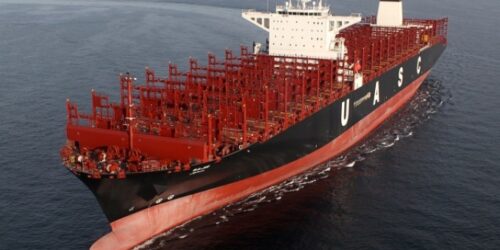According to shipbroker Gibson, the current orderbook for LNG-fuelled vessels stands at over 130 ships, including 40 containerships.
“Of these, Hapag-Lloyd has six 23,000 teu vessels under construction at DSME, CMA CGM has four 22,000 teu vessels on order, along with nine 15,000 teu vessels at HHI, while Eastern Pacific Shipping has 10 14,800 teu ships on order from HHI,” reported Gibson.
However, there is little appetite for ordering smaller LNG-fuelled container vessels, due to the size of bunker tanks required.
Moreover, the hefty price tag for conversion to LNG appears to rule out any significant retrofitting.
Alphaliner reports that Hapag-Lloyd has finally returned its 14,993 teu Sajir to service, after a seven-month conversion that cost some $35m – notwithstanding the loss of earnings of the six-year-old vessel.
It has been renamed Brussels Express and now has a reduced capacity of around 14,600 teu, with its $120m valuation by VesselsValue unchanged by the conversion to LNG.
The Sajir was one of 17 so-called ‘LNG-ready’ ULCVs Hapag-Lloyd inherited from its merger with UASC in 2017, but it seems unlikely that the carrier will be prepared to spend time and money on any further conversions.
Alphaliner argued that ‘LNG-ready’ really only meant a conversion to run on the gas was possible.
“It does not mean that such a conversion is necessarily easy, or makes economic sense,” said the consultant.
“Until conversion prices come down and tonnage demand has reduced sufficiently to ease the pain of having a large mainline ship out of service for several months, new conversion projects seem rather unlikely,” said Alphaliner.
Nevertheless, Hapag-Lloyd’s expensive retrofit of the Sajir/Brussels Express will potentially see the vessel achieve a CO2 emissions reduction of up to 30% and a sulphur dioxide and particulate matter reduction of more than 90% on its new deployment on THEA’s Asia-North Europe FE4 extra loop.
LNG-fuelled containerships have been championed by CMA CGM, which like Hapag-Lloyd, sees LNG as the “most environmentally friendly, readily available fuel for shipping today”, and as a transition fuel on the pathway towards the industry goal of net-zero GHG emissions for shipping by 2050.
In contrast, Maersk is piling millions of dollars into research and development of non-fossil fuels, such as ammonia, methanol and hydrogen, and has so far declined to go down the ‘mid-term’ LNG route – thus, its newbuild orderbook is virtually empty.
And tomorrow, the SEA-LNG industry lobby group will release the results of its second lifecycle GHG emissions study on the use of LNG as a marine fuel.
At the same time, although impractical for deepsea shipping, battery-powered ferries, car carriers and shortsea vessels are edging closer to becoming a reality.
Norwegian car-carrier operator UECC confirmed today it would receive a further two LNG/battery hybrid PCTCs (pure car/truck-carriers) next year, following the launch of the first in the series of 3,600-car capacity ships in Shanghai on Monday (pictured below).







